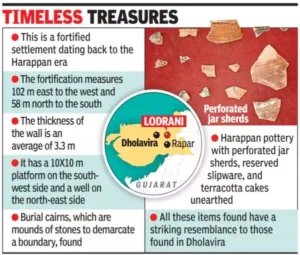
Why in news?
- Local residents of Lodrani stumbled upon Morodharo, a Harappan-era settlement reminiscent of Dholavira. Archaeologists are gearing up for an in-depth investigation and excavation of the site, which is speculated to belong to the mature to late Harappan period. This discovery significantly contributes to our understanding of India’s ancient history.
About Morodharo
- Morodharo is a fortified settlement dating back to the Harappan era.
- Location:
- Located in the Kutch District, Gujarat.
- Features:
- The settlement spans from mature (2,600-1,900 BCE) to late (1,900-1,300 BCE) Harappan periods.
- The fortification measures 102 meters east to west and 58 meters north to south.
- Wall thickness averages 3.3 meters.Features a 10×10 meter platform on the southwest side and a well on the northeast.Burial cairns, mounds of stones demarcating boundaries, are found here.
- Unearthed Harappan pottery includes perforated jar sherds, reserved slipware, and terracotta cakes, resembling those found in Dholavira.
Key Facts About Harpan Civilization
- The Harappan Civilization, also known as the Indus Valley Civilization, was one of the earliest urban societies in the world, flourishing from around 2600 BCE to 1900 BCE.
- Here are some key facts about this ancient civilization:
- Geographical Extent:
- The Harappan Civilization covered a vast area, including parts of present-day India, Pakistan, Afghanistan, and Iran.
- Its major urban centers were located in the fertile plains of the Indus River and its tributaries.
- Urban Planning:
- Cities of the Harappan Civilization, such as Mohenjo-Daro and Harappa, were meticulously planned with well-organized streets, drainage systems, and advanced architecture.
- They had brick-lined streets laid out in a grid pattern, with houses featuring multiple rooms and courtyards.
- Writing System:
- The Harappans developed one of the world’s earliest writing systems, known as the Indus script.
- However, it has not yet been deciphered, so our understanding of their language and writing remains limited.
- Trade and Economy:
- The civilization was engaged in long-distance trade, evidenced by the presence of Harappan artifacts in Mesopotamia and other regions.
- They traded in goods such as pottery, beads, metals, and possibly even agricultural products.
- Technological Advancements:
- Harappans were skilled craftsmen, producing high-quality pottery, intricate seals made of steatite, and metal objects using bronze and copper.
- They also had sophisticated irrigation systems for agriculture.
- Religion and Culture:
- Although much about their religious beliefs remains speculative, the discovery of figurines, seals depicting animals, and evidence of ritualistic practices suggests a complex religious and cultural life.
- Decline and Disappearance:
- The reasons for the decline of the Harappan Civilization are still debated among scholars.
- Possible factors include environmental changes, such as shifts in river courses or climate, as well as social, political, or economic upheavals.
- Legacy:
- Despite its decline, the Harappan Civilization left a lasting legacy in the Indian subcontinent.
- Many aspects of their culture, technology, and urban planning may have influenced later societies in the region.
Urban Planning in Harappan Cities
- Division into Citadel and Lower Town:
- The cities were structured with an upraised citadel in the western part, featuring large buildings like granaries, administrative structures, and courtyards. Below the citadel lay the lower town, consisting of brick houses for common people.
- Use of Burnt Bricks:
- Burnt bricks were extensively used in construction, indicating the absence of stone buildings during the Harappan era.
- Distinct Residential Areas:
- Residential areas were clearly demarcated, with houses made of baked bricks, sometimes multiple stories high, showcasing urban sophistication.
- Houses typically surrounded courtyards, with some having private wells and ventilated bathrooms.
- Street-facing windows were absent, and bathrooms were tiled.
- Sophisticated Drainage Systems:
- Elaborate drainage systems were integral to Harappan cities, with every house connected to street drains.
- Drains were constructed using mortar, lime, and gypsum, ensuring efficient waste disposal.
- Granaries and Storage Facilities:
- Well-planned granaries and storage facilities were present in Harappan cities to store surplus agricultural produce, reflecting advanced urban planning and management.
People also ask
Q1. How were Harappan cities structured?
Ans: Harappan cities were divided into two main parts: the upraised citadel and the lower town. The citadel, located in the western part of the city, housed large buildings such as granaries, administrative structures, and pillared halls. Below the citadel lay the lower town, where common people resided in brick houses.
Q2: What makes Morodharo significant in Harappan history?
Ans: Morodharo is a fortified settlement dating back to the Harappan era, located in Gujarat’s Kutch District. It spans from mature to late Harappan periods, offering insights into ancient urban development. Notable features include fortifications, platforms, and burial cairns, enhancing our understanding of its historical importance.
Q3: What have archaeologists discovered at Morodharo?
Ans: Excavations at Morodharo have revealed Harappan pottery like perforated jar sherds, reserved slipware, and terracotta cakes, similar to those found in Dholavira. The settlement features robust fortifications, a 10×10 meter platform, and burial cairns, providing valuable clues about its layout and significance in Harappan civilization.
Your article helped me a lot, is there any more related content? Thanks! https://accounts.binance.com/zh-TC/register?ref=VDVEQ78S